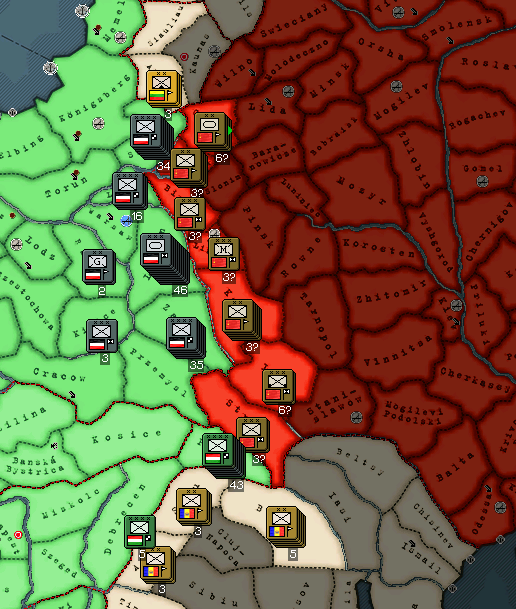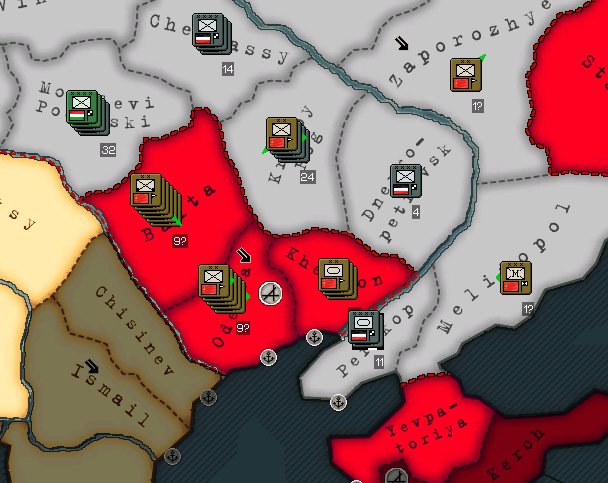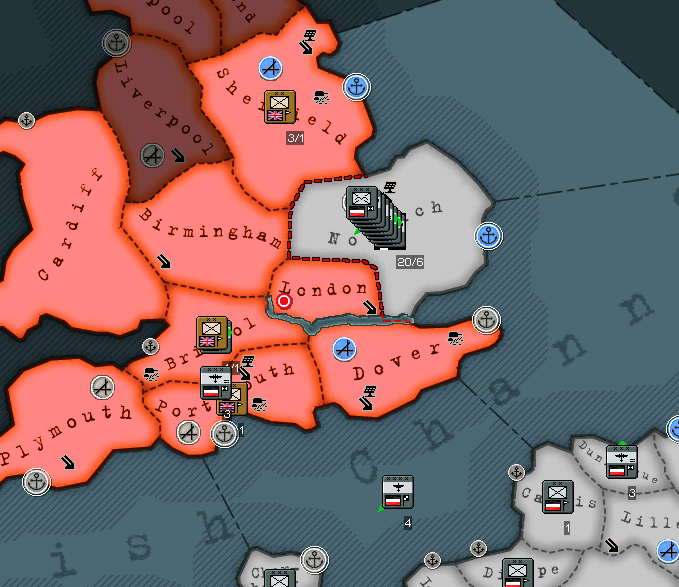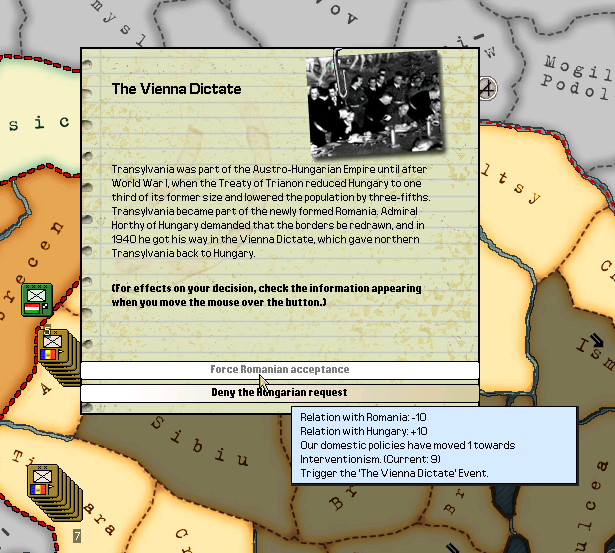With the fall of Yugoslavia, Greece was the only remaining Allied nation in the Balkans. With the Italians failing to make progress, the German Wehrmacht advanced towards the border. In order to quickly take Greece out of the war Salonika and Athens were targeted as the primary objectives. German Panzers quickly rushed towards Athens while German infantry engaged the Greeks in the fortified area around Salonika. Once both areas had fallen, the Italians quickly annexed the rest of the country.
Relations between Germany and the fascist government of Hungary had been steadily improving over the previous months. Soon after the capture of Greece, Hitler offered to make Hungary a member of the Axis. The Hungarians quickly accepted joined the German war effort.
With the war entering the Spring of 1940, Germany launched the next phase of it's plan for world domination; the invasion of the Soviet Union. War was declared on May 28.
Soviet forces along the border were miniscule compared to the massive army the Germans had gathered. However, German intelligence reports indicated that the Soviets had a rather large army that was most likely stationed in the interior. The German advance consisted of three main groups. In the north along the Lithuanian border, 34 divisions would push northwards to Leningrad. In the center, 46 divisions would push towards Moscow, and in the south, 43 divisions of German and Hungarian soldiers would push through Ukraine towards Stalingrad and the south. An additional 51 divisions were positioned between the groups and would assist them with their objectives along the way.

German Panzers quickly rolled across the countryside, quickly taking much of Belarus and Ukraine. The infantry followed to close in on the Russian troops encircled by the fast moving tanks. The Germans were approaching Kiev and deep into Belarus, when the Soviets made a confusing diplomatic move...declaring war on the Baltic states. Now the Germans had unofficial allies in Estonia, Latvia, and Lithuania.
While the Wehrmacht was busy with the intense fighting in Russia, the German forces that had landed in Norway were now finishing off their mission. They pushed up the Norwegian coast in pursuit of the only NOrwegian division that hadn't been defeated. As they took the port of Narvik, the Norwegians officially surrendered.
In the Ukraine, the Germans had taken Kiev and advanced south towards Crimea. A group of Soviet infantry and armour had taken up defensive positions around Odessa attempting to halt the German advance of mostly infantry. 11 Panzer divisions headed south from Kiev along the Dneiper river and succeeded in cutting off over 20 Soviet divisions from their supply routes. Once the encirclement was complete, the Germans began closing in from all sides, eventually destroying the Soviets.

With the Soviet campaign going well, a bold new plan was put into place. In a combined strike using paratroopers and amphibious landings, the Germans made their first landing in Britain. From the airstrip in Lille, 6 transport planes took off and paradropped into Norwich. At the same time, the Kriegsmarine had snuck out of the Baltic Sea and rebased in Ghent. As soon as the planes were in the sky, they set out across the channel to land in coordination with the airdrops. The paratroopers landed unhassled and quickly seized the port, allowing the German ships to sail right in. With 12 divisions now in England, the Germans marched into London, which was suprisingly undefended.
With the Germans quickly advancing through Russia, the Soviets campaign against the Baltic states was far from successful. Their only real victories came against Estonia, which they soon annexed, however the Latvians managed to push the Soviets right out of their country and began advancing into Soviet Estonia.

By the end of July, the Germans had reached reached Moscow, and were closing in on Leningrad and Stalingrad. The Soviets were quick to set up the defense of their capital, which was being constantly bombarded by German and Hungarian planes. With 47 divisions on the city limits, the Germans attempted to take the city. Despite facing only 20 divisions, the Germans were unable to advance any further. German commanders sat back and waited for reinforcements to arrive. Soon, more German divisions arrived, and another attempt was made at the city. This too, would prove futile, as the Soviets fiercly defended their capital. By the end of August, German Panzers had completed an encirclement of the city. Hitler had demanded that the city be taken before the winter arrived. The Russians fought just as fiercly as before, but this time the Germans were successful. 24 Soviet divisions were killed or captured as the Germans triumphantly took control of Moscow. By now, the Germans had completely routed the Soviets in the south and were marching through in the face of almost no resistance. Stalingrad had fallen, and 6 Panzer divisions were rushing towards Baku. In the north, Soviet forces were still holding back the German advances. So far they had successfully defended Leningrad, and were holding back the Germans in Karelia.

Germany's newest ally, Hungary, was feeling confident in the new power they held as a member of the Axis. As a result, they demanded that Romania cede lands that had once belonged to them. Fearful of German reprisals, the Romanians reluctantly accepted the Vienna Dictate which gave parts of Transylvania to Hungary.
Back on the British front, German forces quickly pushed across the English countryside, taking all of the major English cities. Soon all of England and Wales had fallen and 4 British divisions were all that remained for the defense Scotland against the 12 German divisions.
Germany, September 18, 1940
Notice how Latvia has actually taken half of Estonia.



 ) and there's peace with the Allies, Russians don't get anything from the US and they're more likely to surrender.
) and there's peace with the Allies, Russians don't get anything from the US and they're more likely to surrender. 














